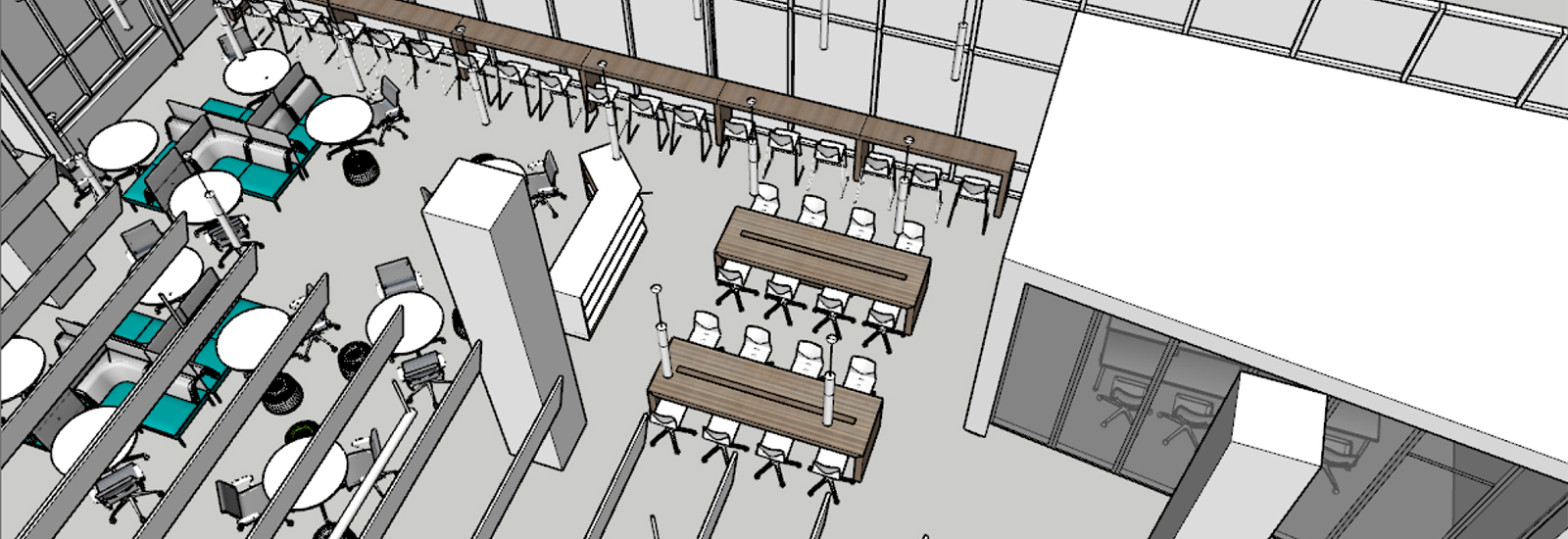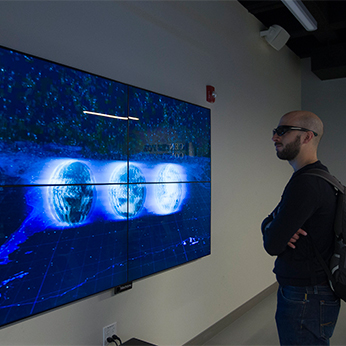by Robert C. Jones Jr.
UM News
They’ve been laboratory staples for what seems like forever. But in one recent experiment, the test tubes and Petri dishes just weren’t the right tools for the job. Instead, the 48 students in the integrated chemistry-biology class needed something different—and better—to test their theories of how yeast would behave after its DNA was altered.
So they turned to an unlikely source: UM’s Richter Library, where a new Learning Commons with a 3D printer-equipped Digital Media Lab allowed the students to fabricate new devices to complete their research.
“They built authentic, never-before-created tools, and they were all different,” said Leslie Knecht, the analytical chemistry instructor who co-taught the course last fall semester.
Without the Learning Commons and its Digital Media Lab, said Knecht, it would have been difficult, if not impossible, for her students to finish their projects.
Chemistry students, however, are not the only undergraduates to reap the benefits of this burgeoning space that has transformed the Richter’s first floor into what Kelly Miller, associate dean for learning and research services at UM Libraries, calls “a hub for learning all kinds of new skills and technologies and interacting with other people.”
Students who need help with writing an essay, solving a differential equation, analyzing and managing data, fabricating board game pieces for a class project, honing their time management skills, or just collaborating with others are all finding the help they need at the Learning Commons, a “one-stop shop” that has consolidated academic services once located in different areas around the Coral Gables campus.
The Writing Center, Math Lab, and UM Information Technology’s Student Technology Help Desk are now all based at the Learning Commons. A Geographic Information Systems Lab, Data Services, Digital Humanities division, and a Learning and Research Services division are also included. UM’s Camner Center for Academic Resources offers consultations there but will maintain its headquarters at the Whitten University Center.
“Our philosophy is to support students in and outside the classroom,” said Maria Stampino, senior associate dean for academic affairs in the College of Arts and Sciences. “The Learning Commons changes the way students access the services they need. If, for example, a student is writing a paper for an ecosystem science and policy class and discovers she’s not up to speed on the quantitative portion, she can get help for both the writing and the quantitative components at one location.”
Morgan McKie, multimedia specialist in the Digital Media Lab, has witnessed firsthand the soup-to-nuts features to which Stampino refers. She noted a recent instance in which a student getting help with statistics at the Math Lab consulted with the Digital Media Lab to learn how to present her data in a visually appealing format. “We’re seeing a lot more of this,” said McKie.
Half of the Richter Library’s first floor has been reconfigured to accommodate the addition of the academic services that make up the Commons. New furniture and help desks and new signage and paint schemes designating the different academic areas have given the first floor a new look. An area that will showcase student projects and provide other services is still under construction, but could be completed in time for the spring 2018 semester.
It all started two years ago, when College of Arts and Sciences Dean Leonidas Bachas expressed a desire to find a new home for the Writing Center, which had long been located in La Gorce House, one of the World War II-era structures on the Coral Gables campus.
From that point on, the idea for a dedicated space that would house not only the Writing Center but also other academic services snowballed. UM formed a Learning Commons Steering Committee, co-chaired by William Scott Green, senior vice provost and dean of undergraduate education, and Charles Eckman, dean of Libraries. Brightspot Strategy, a New York City-based design and management consultant, helped facilitate the vision, mission, and service model for the new space, reaching out to students, faculty and administrators for input.
Now, after an initial pilot phase that lasted during the 2016-17 academic year, the Learning Commons will be celebrating its official opening in Spring 2018.
“The Learning Commons is a bold new venture that will help students acquire and strengthen the essential skills—numeracy, literacy, foreign language, technology and research—they need to learn on their own,” said Green. “It will bring students from every field and background together to learn with and from one another and enhance UM’s unique educational community.”
Students are using the space in impressive numbers, according to Miller. “More often than not, students spend a great deal of their time in libraries,” she said. “They believe it’s the place where they do their best work. We heard them say, ‘We want more opportunities for creativity.’ So we created a service model that incorporates all of our different partners but also connects with students and their learning and research process.”
The Learning Commons, said Eckman, has helped rebrand the Richter Library “as not just a place for private study and sitting amidst large collections of print materials but as a place where students can learn, develop, and grow individually, in groups, and in collaboration.
“The library’s always been a place where people meet and where they do things in an environment that’s neutral,” Eckman continued. “It’s kind of a Switzerland on campus. We’re not really changing any reporting lines when we co-locate these services. We’re just bringing in new partners, creating a memoranda of understanding as the partners work with us in the space and work together across different silos to create something that’s completely seamless and transparent to the user without us having to change the way in which we organize.”
The concept of a Learning Commons—also sometimes referred to as scholars’ commons, information commons, or digital commons—isn’t new. “It’s a genre of space that universities across the country are creating precisely for the goal of making academic services more convenient for students,” said Miller, who supervised the creation of UM’s Learning Commons and organized a similar space at UCLA, where she served as director of teaching and learning services and head of the Powell Library.
While many other Learning Commons are like food courts, UM’s is different, offering “a shared community space that can be much more flexible and adaptable over time,” said Miller.
As such, future opportunities for the Learning Commons, which is specifically tailored to undergraduates, could center on upperclassmen. Enhanced study space for graduate students on the second floor of the Richter, a digital scholarship center on the third floor, and improved individual study space in the stacks tower are all possibilities.
Miller said the concept can be easily adapted to other initiatives and in some cases has already been incorporated. A Library Research Scholars program, for example, jointly sponsored by Green and Eckman, closely mirrors the mission of the Learning Commons. As part of the program, librarian faculty-mentored undergraduates engage with the UM Libraries’ research collections and service programs, building on their own interests, developing transferable skills and creating an intellectual product they can share with others.
And with UMIT and UM Libraries recently announcing that all students will have access to the Adobe Creative Cloud suite of software, the potential for the Learning Commons is limitless. “That fits precisely what we’re about—helping students gain better access to tools of creativity,” said Miller.
“This is the new currency in education,” said J. Tomás López, professor and head of electronic media and chair of the Department of Art and Art History, who was an original Adobe Photoshop tester in 1990. “We’re moving into a world where our schools and colleges are all going to be combining resources.”
Added Eckman, “I like to believe we’re doing something that’s going to be emulated elsewhere, and I think we’re doing it really well. When [the Learning Commons] is complete, it’ll be something for the University to be proud of, to show off.”






